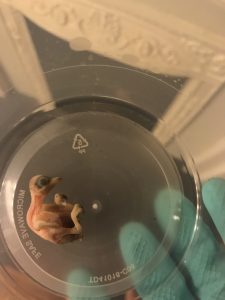A bird in your hand is worth reading this article.
By Katherine Amidon (Posted August 21, 2019):

This baby bird, shown in a plastic container shortly after its discovery, probably fell from a nest up the chimney. In most instances, you should place an orphaned baby bird in a shoebox (with holes poked in the top), and take it to experts for rehab.
It’s 10 p.m., and I hear a soft squeaking sound coming from my closed-off chimney. I live in an old house (1940s), and the coal-burning fireplace — with an opaque decorative cover — is purely aesthetic. I initially think it must be a pesky mouse; we’ve been having issues with those creatures elsewhere in the house, and the last thing I want to do is deal with a mouse chase at this hour. I use my flashlight and barely pull back the fireplace cover to have a quick look. Nothing runs, jumps, or flies out at me. I have no idea what to think until I see the little helpless body of a baby bird, eyes still closed, chirping for its mom.
What do I do? When these displaced-animal moments come up in life, most of us struggle. We didn’t take a class titled “There’s a Bird in My Chimney — What Should I Do?” But in my case (and yours if you’re reading), there is help right here at SynTerra! Our resident bird enthusiast, Chad Ponce, walked me through some things we can do.
Your good intentions could be trouble
First, be warned that it can be illegal to rehab a bird. Whenever possible, leave the bird (or any wild creature) where you found it if you think it can get where it needs to go by itself. If, however, like in my case, the creature is in danger or hurt, you could try to return it to its nest, but be sure to wear gloves. I did not have the ability to do this given that I couldn’t reach the nest in my chimney. I did what I thought was the next best thing and took the bird to an abandoned nest outside in hopes that mother bird would hear her baby. In reality, I think I knew that this bird was probably a goner given its frail condition. In this case, I let nature take its course.
One option I didn’t think about is calling a local rehabilitation place. There is one near our headquarters in Greenville, SC, that even has a helpful graphic titled: “I Found a Baby Bird … Now What?” (more information below). The next day, I called a local chimney company. They recommend that to avoid a repeat occurrence next year, I should have my chimney cleaned and capped. They also informed me that I likely had chimney swifts, which are federally protected, and based on feathers from the mother bird, they could have been right. So what are chimney swifts? Chad provided the following information.
“Cigars with wings”
Chimney swifts (Chaetura pelagica) are small common swifts in North America that are often described as “cigars with wings.” In Pre-Colonial North America, chimney swifts nested in tree snags (standing hollow/dead trees) in mature forests. With the anthropogenic loss of old-growth forest, the chimney swift adapted to using brick chimneys for nesting, likely allowing their populations to increase and range to expand from Pre-Colonial times (Steeves et. al., 2014). Chimney swift populations are now in a long-term decline, reduced 72 percent from 1966 to 2015, according to the North American Breeding Bird Survey (Sauer et. al., 2017). There is some debate in the scientific community as to the cause of the population decline. Some believe that habitat loss is the primary cause. Another hypothesis is that the use of dichlorodiphenyltrichloroethane (DDT) in the mid-20th century caused the primary prey of the swifts to change, which caused nutritional consequences leading to declining populations (Fitzgerald et. al., 2014 and Nocera et. al., 2012). To address the first concern, chimney swift towers can be constructed to house nesting swifts. They are rather large, so perhaps this is more of a community project than a DIY at-home project.
Approximately 99 percent of the chimney swift population breed in the United States and migrate to the upper Amazon basin of South America for the winter (Steeves et. al., 2014). During the breeding season, they look for prime nesting locations like caves, hollow trees, or maybe your chimney. If a chimney swift determines that your chimney would be a great place to breed, don’t fret, they have a short nesting period (2-3 weeks) and will provide you with insect disposal services while they are around (approximately 2 months). Chimney swifts construct their nests by using their saliva to glue twigs to a vertical surface. When a nest is built inside of a chimney with a layer of soot, there is potential for the nest to become unstable and slough off during extreme weather changes and heavy precipitation/humidity. To prevent this from happening (and to prevent chimney fires due to soot build-up and debris), have your chimney cleaned once a year, after nesting season. A chimney swift does not adhere well to a metal-lined chimney (rather than clay or ceramic); therefore, a metal-lined chimney should be capped to prevent nesting.
What do you do if a naked and helpless chimney swift nestling falls from its nest and ends up squeaking pitifully on the floor of your fireplace? Find a shoebox to put it in. No, this is not a bird coffin, so don’t forget to poke some holes and provide a soft liner for the interior. The little guy will need to go to rehab. Rehabilitation of migratory birds requires a permit from the U.S. Fish and Wildlife Service due to the Migratory Bird Treaty Act. The South Carolina Department of Environmental Control (SCDHEC) maintains a registry of licensed rehabilitation experts in each county. Go to the website and find a rehabilitator in your area who will take your bird (or whatever other injured/orphaned/sick animal you have). If you want to get involved in animal rehabilitation yourself, check out Wildlife Rehab of Greenville for volunteer opportunities.
References
Fitzgerald, T.M., E.V. Stam, J.J. Nocera, D.S. Badzinski. 2014. Loss of Nesting Sites is Not a Primary Factor Limiting Northern Chimney Swift Populations. Population Ecology. February 7, 2014. Vol. 56, Issue 3, pp. 507-512.
Nocera, J.J., J.M. Blais, D.V. Beresford, L.K. Finity, C. Grooms, L.E. Kimipe, K. Kyser, N. Michelutti, M.W. Reudink, and J.P. Smol. 2012. Historical Pesticide Applications Coincided With an Altered Diet of Aerially Foraging Insectivorous Chimney Swifts. Proceedings of the Royal Society. April 18, 2012. Vol. 279, Issue 1740.
Sauer, J. R., D. K. Niven, J. E. Hines, D. J. Ziolkowski, Jr, K. L. Pardieck, J. E. Fallon, and W. A. Link. 2017. The North American Breeding Bird Survey, Results and Analysis 1966 – 2015. Version 2.07.2017 USGS Patuxent Wildlife Research Center, Laurel, MD
Steeves, T.K., S.B. Kearney-McGee, M.A. Rubega, C.L. Cink, and C.T. Collins. 2014. Chimney Swift, Chaetura pelagica. Cornell Lab of Ornithology. Version 2.0. April 25, 2014.





